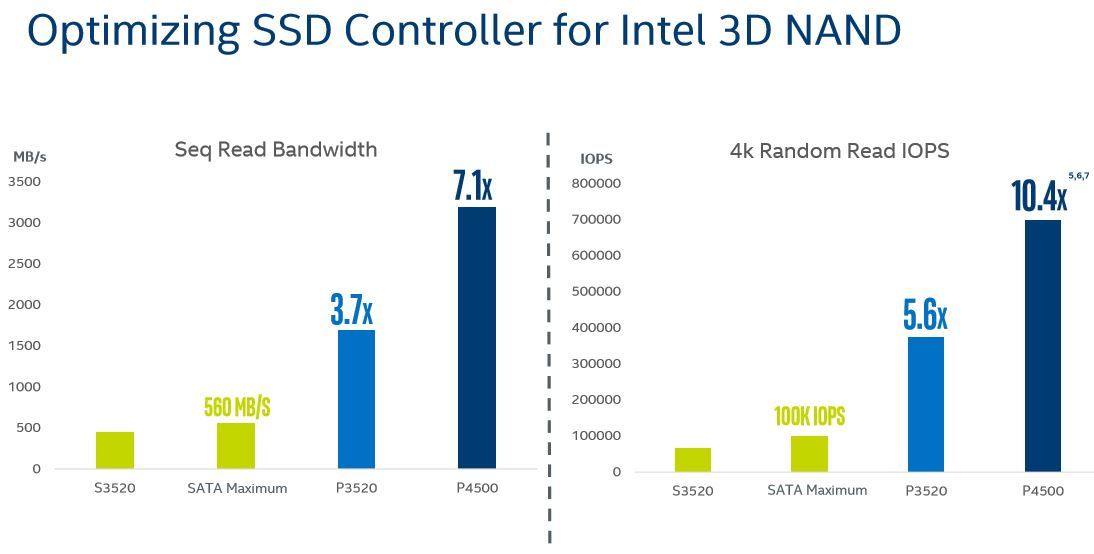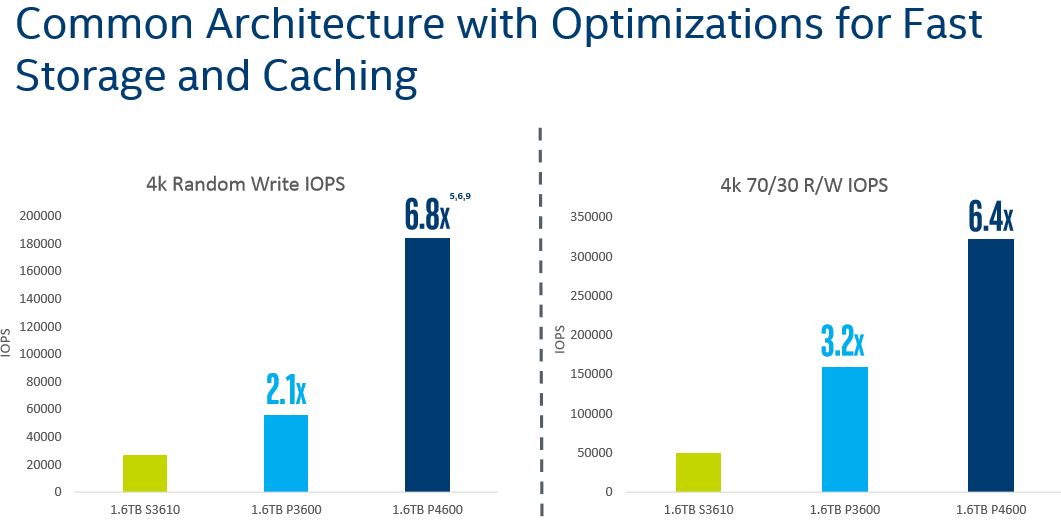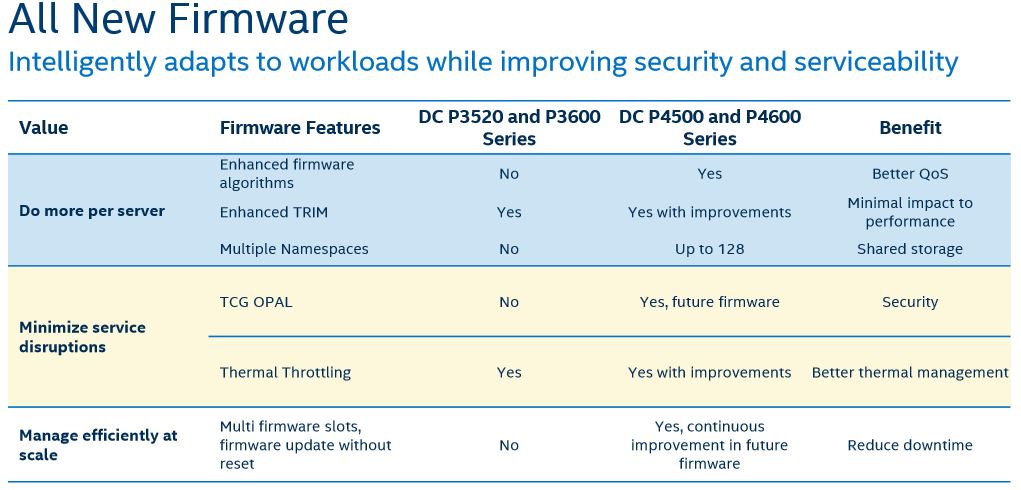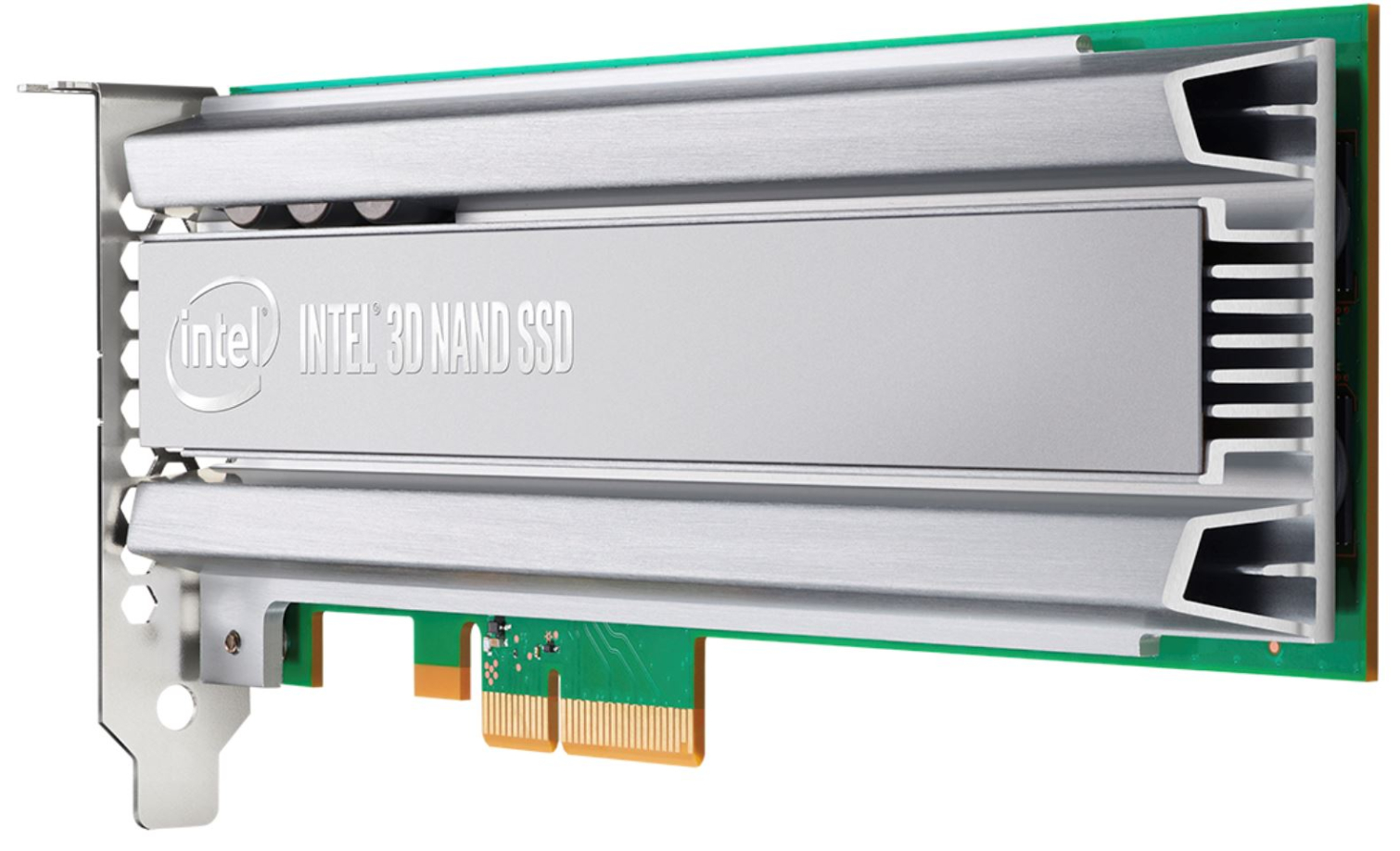Intel Announces SSD DC P4500 and P4600 Series
Intel is revamping its enterprise SSD lineup with two new offerings that feature TLC 3D NAND and a new SSD controller that brings a range of new features, including increased performance and simplified management capabilities.
We've seen the client SSD market transition to 3D TLC NAND en masse, and we expect the same trajectory for the enterprise space, too. 3D NAND offers plenty of advantages, such as increased endurance and reduced power consumption, but most importantly, it offers lower pricing and increased density. The Intel DC P4600 and P4500 employ Intel's first generation 32-layer TLC NAND with 384Gb die.
| Header Cell - Column 0 | Intel DC P4600 | Intel DC P4500 | Intel DC P3520 | Intel DC P3700 | Intel DC P3608 |
|---|---|---|---|---|---|
| Capacity | 1.6/2/3.2/4TB | 1/2/4TB | 1/1.2/2/3.2TB | 400/800GB 1.6/2.0TB | 1.6/3.2/4TB |
| NAND | 20nm IMFT 3D TLC NAND | 20nm IMFT 3D TLC NAND | 20nm IMFT 3D MLC NAND | 20nm MLC NAND | 20nm MLC NAND |
| Random Read IOPS (up to) | 702,000 | 710,000 | 365,000 | 460,000 | 870,000 |
| Random Write IOPS (up to) | 257,000 | 68,000 | 22,000 | 175,000 | 110,000 |
| Sequential Read MBps (up to) | 3,280 | 3,290 | 1,600 | 2,800 | 5,000 |
| Sequential Write MBps (up to) | 2,100 | 1,890 | 1,400 | 2,000 | 2,300 |
| Power Operating/Idle | 9.9/20.7W - Idle ? | 10.9/18.3W - Idle ? | 12/25 - 4W | 25 - 4 W | 25/50 - 8-10 W |
| Form Factor | AIC & U.2 | AIC & U.2 | AIC & U.2 | AIC & U.2 | AIC Only |
| Endurance (up to) | 21,700 TBW/4 DWPD | 4,600 TBW/0.7 DWPD | 2,490 TBW/0.35 DWPD | 43,800 TBW/17 DWPD | 21,900 TBW/3 DWPD |
Intel's vertically integrated design employs the company's own NAND, controller, firmware, and components. The new fourth-generation controller features 12 channels (four CE per channel), whereas previous-generation controllers employed 18 channels. Paring back the channel count confers reduced power consumption, but in this case, it also yields a net performance gain. The performance increase is surprising in light of the transition to TLC NAND, which typically results in lower performance. Intel employs a dual-PCB design to house the hefty allotment of NAND, but it hasn't specified which capacity points leverage a daughterboard. The company also claims the new controller is more scalable than previous generations, so we could see higher capacities in the future with the same platform. Endurance is also a notably impressive metric in light of the TLC NAND. The DC P4500 features 10% overprovisioning, while the DC P4600 steps up to 30%.


Aside from the fancy new heatsink (which is the same as the 3D Xpoint-powered Intel DC P4800X), the DC P4600 brings up to 702,000/257,000 read/write IOPS, which is a big improvement over the previous "standard" Intel enterprise SSDs. In fact, only the DC P3608, which is two SSDs melded onto one PCB, offers more random read IOPS, and it pales in comparison with random write performance. Notably, the increased performance offers superior IOPS-per-TB metrics, which is an important factor in the data center. Sequential throughput metrics are also impressive for a single-ASIC design.
That all comes down to firmware and controller optimization. One of the more notable aspects of the series is the step up to more submission/completion queues. These queues spread out amongst the processor cores to offer increased performance and consistency. Intel has also enabled "snap reads," which allow the controller to read only a NAND page instead of wasting time processing the entire block. The company also added the capability to suspend in-flight background operations, such as garbage collection, to prevent interference that can impact read performance. Intel also coalesces TRIM commands and can suspend them to prevent interference with time-sensitive operations. The culmination of the techniques improves both performance and consistency.
We don't have more fine-grained specifications, such as detailed QoS metrics, due to Intel's new policy of not releasing product manuals. This notable departure from the norm is the result of an unnamed competitor duplicating some of Intel's SMART implementation. That's unfortunate. As such, Intel customers will not get access to the product manual without a signed NDA. Intel did provide the basic 99.99th percentile metric of 500 microseconds with a 4K QD1 workload, which is an impressive 8x improvement compared to the DC P3700.


Intel stepped up to NVMe 1.2, which offers new management features and performance optimizations for large deployments, and still employs the PCIe 3.0 x4 connection. The increased capabilities of the NVMe Management Interface (NVMe-MI) allow the company to offer increased telemetry for important metrics, such as latency distributions, SSD health, and temperature monitoring. The new out-of-band management capabilities also allow for OS-agnostic management and firmware updates. The SSD also comes with the expected end-to-end data path and power loss protection features. Support for multiple namespaces also makes its way into the arsenal, which is important for carving up devices into logically separate volumes.
Get Tom's Hardware's best news and in-depth reviews, straight to your inbox.
The new Intel data center SSDs are in production with top cloud service providers. General availability begins in June. The new SSDs feature competitive price points and Intel's standard five-year warranty.

Paul Alcorn is the Editor-in-Chief for Tom's Hardware US. He also writes news and reviews on CPUs, storage, and enterprise hardware.
-
photonboy The most interesting product for the average consumer is the M.2 Optane version used as a cache. It even makes a system with an SSD feel more responsive.Reply
You do need a modern computer (Kaby Lake I believe), but the coolest thing is that you can buy a $45 version and drop it in as a fast cache for a system that only has an HDD. Just buy an SSD you might say... sure, but for a lot of people that can lead to confusion and even severe problems.
If I had a relative with a compatible computer with ONLY an HDD I'd probably just drop in an M.2 Optane device (based on the results from places like PCPER). -
photonboy (for my above comment I might the SSD could cause issues due to CLONING which isn't always perfect, and also just scares people. However, not sure the same class of people would even think to drop in a "cache" device either...)Reply -
WeldonB8 I agree 100%, I'm in the process of customizing an off the shelf pc for my mom and started to do the same thing along with other upgrades, luckily the first I purchased was an SSD and then thought about the point you made and decided to keep it simple (ram, adequate cooling, bigger display etc.) But Ill keep the SSD for it since its big enough to not need a platter so she'll be fine with just a single drive.Reply -
BoredSysAdmin I smell Intel PR poop here. No way in heck TLC nand is so much faster than MLC. Even current leader in SSD - ie Samsung shown us that EVO (3d TLC) could be made pretty fast, but no matter what - MLC is much faster (in Pro models)Reply
New controller or not. Looking at specs - everything is rated "up to", not sustained.
Willing to bet these new drives have healthy SLC cache and performance would drop drastically ones data tested is beyond the cache size. -
photonboy Reply19661699 said:I smell Intel PR poop here. No way in heck TLC nand is so much faster than MLC. Even current leader in SSD - ie Samsung shown us that EVO (3d TLC) could be made pretty fast, but no matter what - MLC is much faster (in Pro models)
New controller or not. Looking at specs - everything is rated "up to", not sustained.
Willing to bet these new drives have healthy SLC cache and performance would drop drastically ones data tested is beyond the cache size.
It's a product announcement, NOT a review as you know so let's just get out there so others aren't confused.
As for your TLC worries, you mention this indirectly, but didn't quote this:
"The performance increase is surprising in light of the transition to TLC NAND, which typically results in lower performance.."
Any company buying this en masse should be looking carefully at the cost vs performance benefits. It's not "Intel PR poop" likely since the average consumer isn't the target. Educated administrators are.
The cache, NAND cost, controller and software architecture appear carefully optimized around performance vs dollar. All we can do is wait for reviews.
*For a video editing consumer with a half-decent PC (i7-3770K) but not amazing there's too much changing right now for me to rebuild my system which may include a prosumer PCIe SSD. Intel OPTANE looks awesome, but only for Kaby Lake AFAIK. Ryzen is interesting, and looking for at least 8C/16T but no Optane.. newer Intel CPU's coming with better value (i.e i9) and more than 8C/16T? .. may see other memory changes in the near future?

